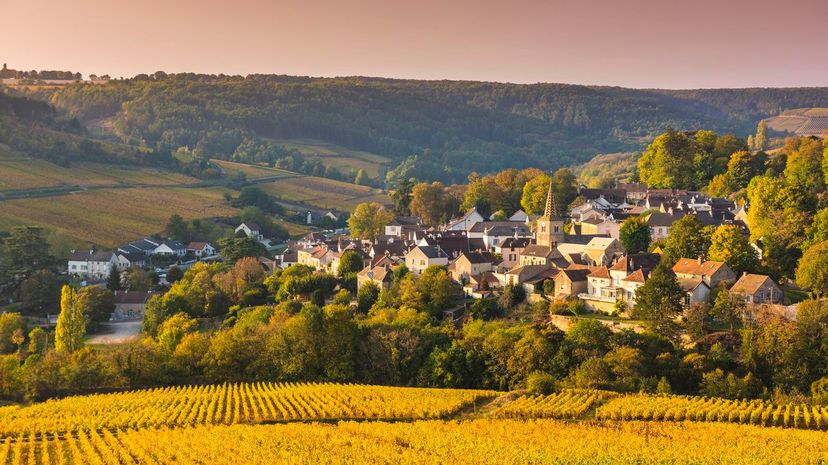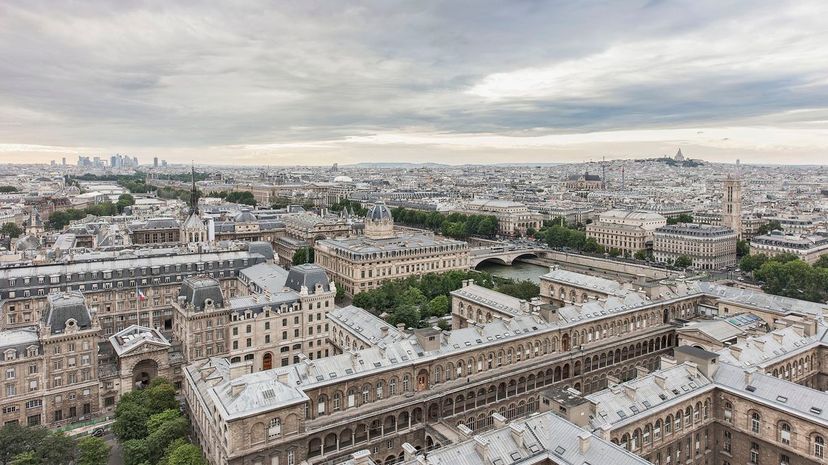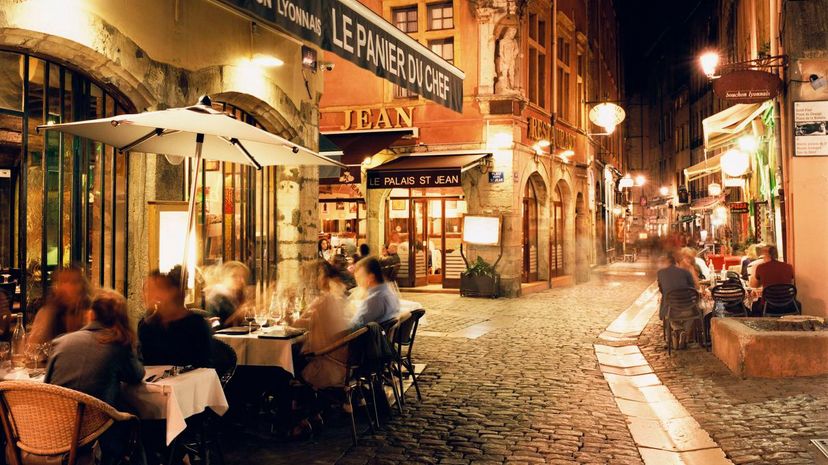
About This Quiz
France has more history than you could shake a stick at with evidence of people living in the area dating back a staggering 1.8 million years. The geography of France has made it not just a viable but desirable location for people to live across the ages, which is why it's been so important for so long. Greeks and Romans established cities like Marseille in the area as far back as 600 B.C. With its wide range of temperature zones from the coldest northern points like the city of Doube to the balmy French Riviera (and tons of rich land well-suited to growing crops like grapes in between), France is a vibrant and lively country. There are abundant lakes and rivers, dense forests, expansive mountain ranges, sandy beaches and bustling metropolitan areas. Whatever kind of land you're looking for, you can probably find a taste of it in France.
If you feel like you're a French geography ace, and you know your Mont Blanc from your Grande Casse or the region of Brittany from the region of Bordeaux, then it's time to grab a nice baguette and some Gruyère cheese and show off your geography skills in the quiz.

Lac du Bourget is generally considered the deepest and, for much of the year, the largest lake in France. There are other lakes like Lake Geneva that are bigger, but that one straddles the border between France and Switzerland

Mont Blanc isn't just the name of a company that makes pens. The mountain, which means "White Mountain" in English, rises to 15,774 feet. It's the highest peak in all of France and also the highest in Europe west of the Caucasus range.

France is the largest country in Western Europe, and its position makes it a hub of activity between many of the countries there since it borders so many. From France, you can get to Germany, Italy, Switzerland, Spain and Belgium, among others.
Advertisement

The Pyrenees mountain range is the natural border between France and Spain. The highest point in the range is 11,168 feet, and it extends about 305 miles from the Mediterranean Sea to the Bay of Biscay in the Atlantic.

France used to be made up of 22 administrative regions. That included places like Burgundy, Alsace, Upper and Lower Normandy, Lorraine, Champagne-Ardenne and others. After 2015, they were reduced to 13 regions by merging several.

The river known as La Loire is 629 miles long. It's the longest in France and the 171st longest in the world. The valleys located along the Loire are known to be extremely lush and the location for exceptional vineyards and other crops.
Advertisement

Not all of France is located in France, but if you account for the overseas territories and the land it's on in Europe, you get a total area of 248,573 sq mi that makes up France. Metropolitan France is about 213,011 sq mi.

France lays claim to five overseas regions that, though they are miles away, still fall under the rule of the French government. They include Guadeloupe, French Guiana, Martinique, Mayotte and Réunion. It's worth noting that they are just "overseas regions" and they are still collectivities, countries and territories that are technically different (and have their own rich histories and cultures).

Paris is an absolutely massive city with a population of 2.4 million. After Paris, the next largest city is Marseilles in the Provence-Alpes-Côte d'Azur region of France. Marseille, which dates all the way back to 600 B.C., has a population of about 870,000.
Advertisement

Toulouse, sometimes called the Pink City, is on the River Garonne. The city started life as a Roman military outpost back in the second century B.C., as it was a prime location along the river for a trading spot.

Bordeaux wine is so popular, it's its own kind of wine, named for the region in France in which you'll find the city. Interestingly enough, there is no wine production in the actual city of Bordeaux, just the region outside of the city where the grapes are grown.

The Upper Rhine river forms the natural border between France and Germany. The river is the second-longest in Europe and spans 760 miles. A number of Germany's most important cities like Cologne and Dusseldorf sit on the Rhine.
Advertisement

The city of Cannes, famous for its yearly film festival, is located on the French Riviera. That means it's right on the Mediterranean Sea. Despite its notoriety, it's a relatively small city with a population of around 74,000.

In France, the English Channel which is the body of water separating France from England is known as La Manche. That translates literally as "the sleeve." They've been using that name for it since sometime in the 17th century.

Marseilles is the city that sits at the mouth of the Rhone where it empties into the Mediterranean Sea. It's France's largest city on the sea and their largest port as well. It was originally founded as the Greek colony of Massalia.
Advertisement

France has 13 regions currently after some governmental restructuring, and Normandy is one of them. Historically, it was the Duchy of Normandy and was home to the Norman people who were a blend of the native residents of France and Vikings.

Right at the Western tip of France is where you'll find Brittany, which historically had a Celtic heritage. Britons settled here in the Dark Ages after escaping the Anglo-Saxon invasion in Great Britain.

Corsica is an island in the Mediterranean Sea, and it's the birthplace of Napoleon Bonaparte, who would go on to become the Emperor of France. Corsica was ruled by the Republic of Genoa for a time and was its own Italian-speaking Republic before France took over.
Advertisement

In France, there are 101 departments (so long as you count the overseas territories, which would add another 5 to the 96 mainland, for a nice, round 101 departments in total). But just in what they call Metropolitan France, you're looking at 96.

Those 13 regions are cut into 101 departments, which are then broken into an ungainly 332 arrondissements (including 12 overseas). That's based on 2019 numbers, and it changes more often than you'd think.

Dunkirk is near the border of Belgium and is the northernmost city in France. It's also the northernmost French-speaking location in Europe, though there are a few cities further north if you head to Quebec in Canada.
Advertisement

The Alps stretch through eight countries, starting in France and ending in Slovenia. As far as France is concerned the mountain range creates a natural border between it and the country of Italy. The highest peak, Mont Blanc, spans the border between the two.

La Baule-Escoublac, usually just called La Baule, is a seaside town with a massive 9 kilometer (or about 5.5 mile) stretch of beach. It's not just the longest beach in France; it's the longest one in Europe as well.

The French and Swiss border follows the path of the Jura Mountains. This is a heavily forested region across both countries, and in fact, the name Jura comes from the Celtic word "jor," which means forest.
Advertisement

Known as the A10, the longest road in France connects Pairs to Bordeaux and stretches an impressive 341 miles. The road also goes by the name of L'Aquitaine when A10 sounds just a bit too formal to use.

France is right in the middle of everything in Europe and shares a border with a total of eight different countries. They are Andorra, Monaco, Italy, Spain, Switzerland, Belgium, Luxembourg and Germany.

Once upon a time when the Roman were busy conquering the known world, they settled in the area that is present-day Paris and established a city that was called Lutetia. The name Paris came from a local tribe of Celtic people called the Parisii.
Advertisement

The largest region in France by area is Nouvelle-Aquitaine, which has an area of about 32,446 square miles. The second-largest region is actually not even in Europe. French Guiana is almost as large as Nouvelle-Aquitaine; it just happens to be an island near South America.

Lyon was once known by the somewhat overwhelming name Colonia Copia Claudia Augusta Lugdunum. It was the capital of Gaul, but these days it's the third-largest city in the entire country with a population of about 513,000.

The countries of Germany and France shared a border with the Vosges Mountain range. They're not a particularly massive range of mountains, and the highest peak is called Grand Ballon, which gets up to 4,672 feet.
Advertisement

Dijon is the city that lies the furthest east in this list. Like many French cities, Dijon was once a Roman settlement that was, at the time, known as Divio. Yes, this is also the birthplace of Dijon mustard, where a man named Jean Naigeon substituted the acidic green juice of unripe grapes for vinegar in traditional mustard.

Toulouse is the most populous town in the region known as Occitanie. The population is roughly 458,298, which makes Toulouse also the fourth most populous town in the entire country. A good portion of the population in the area also speak the language called Occitan.

The Côte d'Azur is along the Mediterranean coast of France, though most people know it better in English as the French Riviera. It stretches from Cassis in the west to Menton at the France-Italy border in the east.
Advertisement

The Lascaux Caves are located near Montignac, France and are one of the most historically significant locations in all of Europe if not the world. There are cave pantings inside Lascaux Caves that are believed to be 17,000 years old.

The village of Lamanère is the southernmost town in all of France. Despite the distinction of being the southernmost town in the country, there's not a lot of stuff going on that makes it noteworthy since less than 50 people actually live there.